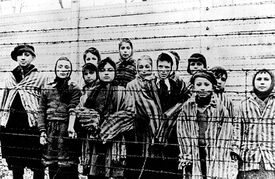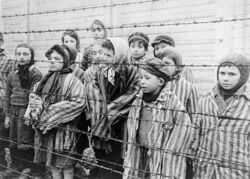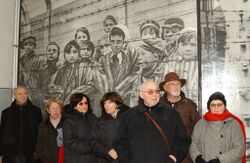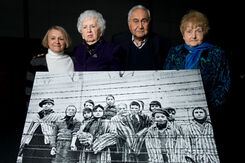Eva Slonim / Eva Weiss (F / Slovakia, 1931), Holocaust survivor
Eva Slonim / Eva Weiss (F / Slovakia, 1931), Holocaust survivor
Marta Wise / Marta Weiss (F / Slovakia, 1934), Holocaust survivor
- KEYWORDS : <Auschwitz> <Liberation of Auschwitz> -- <Australia>
- MEMOIRS : Gazing at the Stars (2014)
Biography
Eva Slonim (née Weiss) was born on 29 August 1931 in Bratislava, Czechoslovakia. Her parents were Eugen Yaakov and Margaret Meital Weis, and she had eight sisters and a brother. During the war, Eva was able to live under an assumed Aryan identity with false papers for a while, but she was eventually arrested in Nitra, and after being severely tortured, she was sent to the Sered camp. On 3 November 1944, she was deported to Auschwitz-Birkenau together with her family.
Eva and her sister Marta (on her left in the photograph) were kept in Mengele’s medical experiments block together with the twins and dwarfs. They managed to stay alive there until the liberation. Eva and Marta were liberated by the Red Army on 27 January 1945. About nine months later, Eva moved to Australia, and today lives in Melbourne. She has five children, 27 grandchildren, and 5 great-grandchildren.
Book : Gazing at the Stars (2014)
- Gazing at the Stars: Memories of a Child Survivor
In March 1939, seven-year-old Eva Weiss’s innocence was shattered by Germany’s invasion of her homeland, Slovakia. Over the next five years, as the Nazi persecution of Europe’s Jews gathered momentum, Eva’s parents were forced to send their children into hiding, but she and her sister Marta could not avoid capture.
In this remarkable memoir, Eva recounts her experiences at the Auschwitz-Birkenau concentration camp. There, she witnessed countless horrors and was herself subjected to torture, extreme deprivation, and medical experimentation at the hands of the notorious Dr Josef Mengele. When the Soviet army liberated the survivors of Auschwitz early in 1945, Eva and Marta faced a new challenge: crossing war-torn Europe to be reunited with their family.
Narrated with the heartbreaking innocence of a young girl and the wisdom of a woman of eighty-three, Gazing at the Stars is a record of survival in the face of unimaginable evil. It is the culmination of Eva Slonim’s lifelong commitment to educating the world about the Holocaust, and to keeping alive the memory of the many who perished.
Auschwitz Picture
She is present in an iconic Auschwitz picture, that depicts 13 child survivors, shortly after the liberation of the camp. All of them have been identified. From left to right they are:
- (1) Tomy Shacham / Tomy Schwarz (M / Slovakia, 1933)
- (2) Miriam Friedman / Miriam Ziegler (F / Poland, 1933)
- (3) Pessa Balter / Paula Lebovics (F / Poland, 1933)
- (4) Ruth Muschkies / Ruth Webber (F / Poland, 1935)
- (5) Bracha Katz / Berta Weinhaber (F / Slovakia, 1930)
- (6) Erika Dohan / Erika Winter (F / Czechia, 1931)
- (7) Marta Wise / Marta Slonim (F / Slovakia, 1934)
- (8) Eva Slonim / Eva Weiss (F / Slovakia, 1931)
- (9) Gabor Hirsch (M / Poland, 1929)
- (10) Gabriel Neumann / Gabriel Nejman (M / Czechia, 1937-2012)
- (11) Shmuel Schelach / Robert Schlesinger (M / Czechia, 1934-2006)
- (12 & 13) Eva & Miriam Mozes / Eva Kor (F / Romania, 1934-2019) and Miriam Zieger (F / Romania, 1934-1993).
Eva Slonim was among the seven children who reunited on 27 January 2005 in the ceremony in Poland marking 60 years since the liberation of Auschwitz (photograph by Dalit Shacham). The group included (from left to right): Tomy Shacham (1); Erika Dohan (6); Marta Wise (7); Eva Slonim (8); Shmuel Schelach (11); Gabriel Neumann (10); and Bracha Katz (5).
In separate reunion four other survivors gathered in Krakow, Poland on 26 January 2015, at the invitation of the USF Shoah Foundation, on the eve of the 70th anniversary of the liberation of the death camp. The Group included (from left to right): Paula Lebovics (3), Miriam Ziegler (2), Gabor Hirsch (9), and Eva Kor (12). (Photo by Ian Gavan/Getty Images).
USF Shoah Foundation
Though they came from the same family, Eva Weiss Slonim and her sister Marta (standing next to each other in the photograph) each had to overcome different challenges to survive the Holocaust.
Eva was born August 29, 1931, the oldest girl among six siblings in her family when World War II began. Though she had had a happy childhood, Germans invaded her hometown of Bratislava, Czechoslovakia, in 1939, and began confiscating Jews’ belongings. Their non-Jewish friends stopped talking to them and Eva remembers German soldiers viciously attacking her grandfather in their home, which was her first sign that the situation was very serious.
Eva’s father, a textile manufacturer and shop owner, employed a beautiful German woman named Mrs. Tafon to take each of the children to relatives’ homes in Hungary on false papers. Only Eva –who with light hair and blue eyes had a greater chance of passing as Gentile – stayed in Bratislava with their parents. Eva would often place dolls in a baby carriage and take them to pick up their food rations so neighbors wouldn’t suspect that the rest of the children were gone.
After about two years, conditions in Hungary became so bad that Marta and the other children attempted to return to Czechoslovakia. Eva and Marta posed as Catholic orphans in a flat in Nitra, Czechoslovakia, for several months, until soldiers interrogated and arrested them. Even Eva’s new friend, a girl her age whose father was a top SS officer, could not save them from being sent to Séréd concentration camp and then to Auschwitz.
Because they were sisters but had different-colored eyes and hair, Eva suspects, she and Marta was sent to Dr. Josef Mengele’s infamous barrack which housed twins and people with physical abnormalities who were to be subjected to his medical experiments. Eva was given injections that gave her stomach cramps, had large amounts of blood drawn, and was forced to play games with the other children in which they inadvertently chose Mengele’s next victims. A sign reading “Each beginning has an end” hung in the barrack.
Eva contracted dysentery and typhoid but Marta stole potatoes for her which saved her life. In January 1945, the approaching Soviet Army triggered the Germans to send the majority of camp inmates on what would be death marches to lands that were still under German control, but Eva and Marta stayed behind, and the Red Army liberated them on January 27, 1945. After a long journey back to Bratislava, Eva and Marta were reunited with their parents and siblings except for one sister who had been killed.
The family immigrated to Australia in 1948 after Eva’s brother died in a drowning accident. Eva worked long days in her father’s new wafer factory and went to school at night. She met her future husband, Benjamin Slonim, at her 17th birthday party. After they were married in 1953, Eva worked as a bookkeeper and secretary and they had five children, Edwin, Malcolm, Sharona, Daniel and Aviva. Eva and Benjamin have 24 grandchildren.




